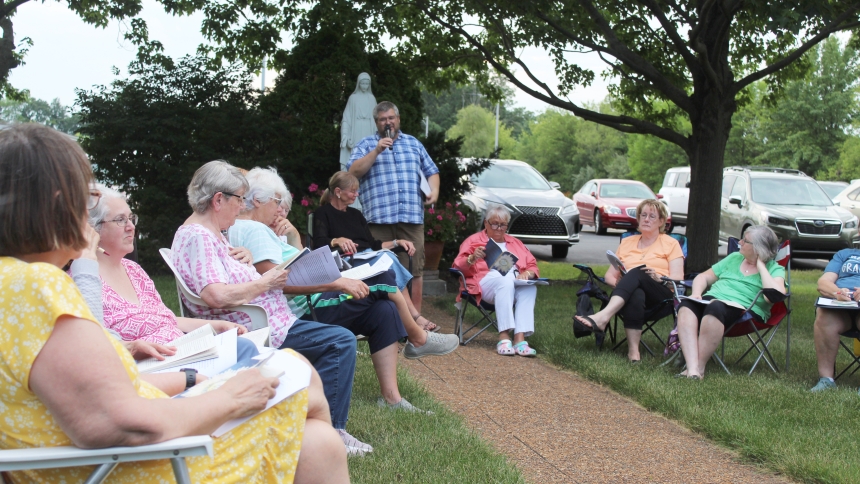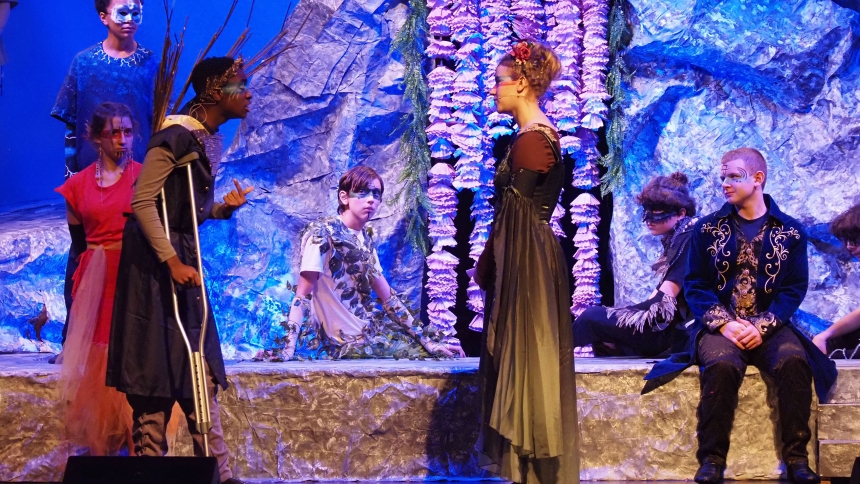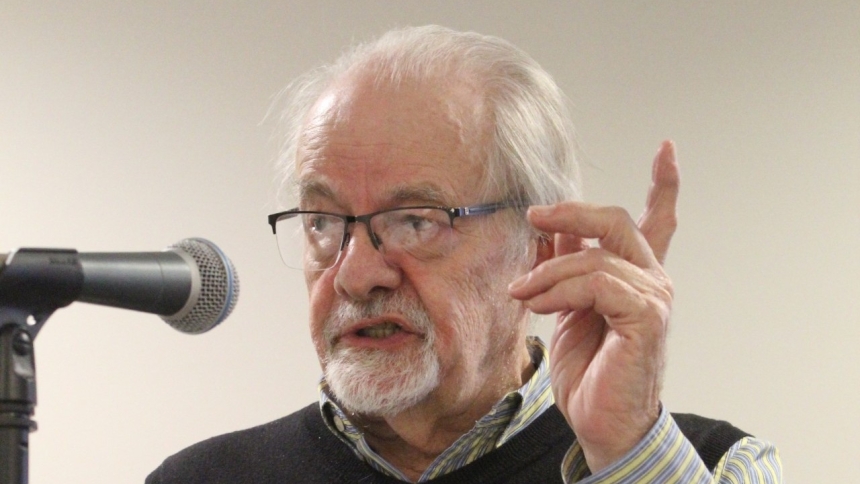
HEBRON – Seven famous saints offered inspiration as local Catholics gathered for the latest session of Gazebo Reflections outdoors at St. Helen on June 30.
The seven-part summer discussion series focusing on the book “33 Days to Eucharistic Glory” by Matthew Kelly, is led by facilitator Laura Roeske and follows a reflection guide written by Father Ian Williams, priest-in-residence at St. Helen, who joined the group for its recent meeting.
Urging Catholics to “be bold,” Kelly’s message in the book is meant to lead readers to a closer relationship with Christ in and through the Eucharist. “I believe it is time we consecrated ourselves to Jesus in the Eucharist – it is time for a Eucharistic consecration,” he wrote.
After an introductory session that laid out Kelly’s dream that the whole world be consecrated to the Eucharist, the second session focused on the faithful, as “pilgrims” on a journey toward Eucharistic consecration.
The third session offered inspiration for that journey in the form of the lives of St. Mother Teresa, St. Pope John Paul II, St. Therese of Lisieux (The Little Flower), St. Maximilian Kolbe, St. Thomas Aquinas, Sister Maria Faustina Kowalska and Blessed Mother Mary.
Roeske prompted attendees to reveal “a personal favorite saint and their reason,” and answers ranged from St. Joseph, praised by Pat Hren for his faithfulness to the Holy Family to St. Ann, “who was a seamstress like me,” noted Michaeline Florek.
Noting that Eucharistic adoration was one of Mother Teresa’s “primary spiritual habits,” Kelly said when people close to her suggested she cut back on the full hour she devoted to adoration each morning as the impact of her work grew, Mother Teresa actually doubled her adoration time to two hours.
Fay Iorio, a Holy Spirit parishioner, found favor with Kelly’s statement that “Our lives change when our habits change,” adding that she remembers her father, a Methodist, being profoundly impacted by meeting Mother Teresa.
Father Williams pointed out that Mother Teresa’s “dark nights of the soul,” revealed by a friend only after her death, spoke of her deep faith. Despite her despair, he said, “she persevered.”
The discussion on the life of Pope John Paul II focused on the contention that he prayed 12 hours a day. “Everything he did was a prayer,” the group agreed, and his call for “a New Evangelism” defined his papacy.
The Eucharistic devotion displayed by Pope John Paul II shows that “it is the center of your life, essential and necessary for our relationship with Christ,” said Marie Pavnica of St. Helen.
St. Therese of Lisieux dreamed of living her faith out loud in a dramatic manner, but instead found a vocation as a cloistered nun, largely due to her frail health that led to her death at 24.
Known for her devotion to “doing little things in big ways” as a way to give glory to God, Roeske suggested that “we can all find something to do each day to make someone feel better” as a way to emulate St. Therese.
The famous story of the sacrifice made by St. Maximilian Kolbe, who offered himself to save a man with a family who was chosen to die in the Auschwitz concentration camp during WWII, is one known by many at the Gazebo Reflections gathering, but Father Williams explained that the priest had earlier “helped thousands of Jews during the war, which led to his (arrest and subsequent) death.
Speaking of sacrifice as a way to grow closer to God, Kathy Jennings of Holy Spirit noted she remembers her “parents didn’t eat anything between meals through all of Lent,” beyond the Catholic Church protocols for fasting and abstinence. “Sacrifice makes it easier to love God,” she said she learned by their example.
Considered one of the greatest minds in human history, St. Thomas Aquinas abruptly stopped writing without finishing his masterpiece, “Summa Theologica” after a vision he had while celebrating Mass one day just three months before his death.
Roeske suggested that St. Thomas recognized “the difference between knowing about someone and (actually) knowing someone” when it came to Christ.
Sister Maria Faustina Kowalska, explained Kelly in his book, lived an obscure life as a religious sister in Poland until she was chosen by Christ to share his message of Divine Mercy through a vision.
The blood and water flowing from the exposed heart of Jesus in the image of his Divine Mercy described by Sister Faustina “is considered a sign of the sacraments,” said Father Williams, and the Eucharist was seen as central to Sister Faustina’s pilgrimage to heaven.
The Blessed Mother is praised for saying “Yes” to God’s plan for her to become the tabernacle of Jesus, and seen as the ultimate example for all people to say “Yes” to God’s will, the discussion group agreed.
Attendees were urged to share Eucharistic joy as Mary did when she rushed out to share the news of her pregnancy with her cousin Elizabeth. “When you receive the Eucharist at Holy Communion, you become Jesus’ dwelling place on earth,” said Roeske.
The book study continues biweekly through Aug. 25, with the next session set for Monday, July 14, at 6 p.m. To join the group, bring a chair and, if possible, read Chapter Days 13-20 on the theme “Rest in Me.” Copies of the book are available at all One Catholic Family churches, St. Helen, Holy Spirit in Winfield, and St. Mary in Kouts.
Caption: Meeting under the watchful eye of a statue of the Blessed Mother on the church campus, Father Ian Williams (standing), priest-in-residence at St. Helen in Hebron guides the Gazebo Reflections group in a discussion of inspirational saints on June 30. The group is meeting biweekly on Mondays through Aug. 25 to share their thoughts about the book “33 Days to Eucharistic Glory” by Matthew Kelly, with the next session set for July 14 at 6 p.m. book “33 Days to Eucharistic Glory” by Matthew Kelly.



